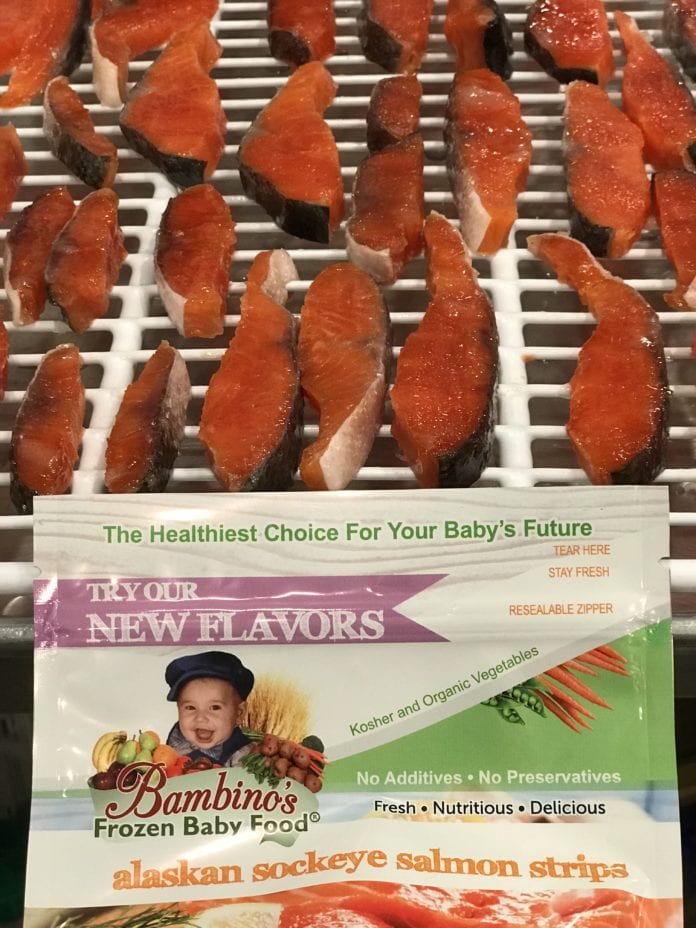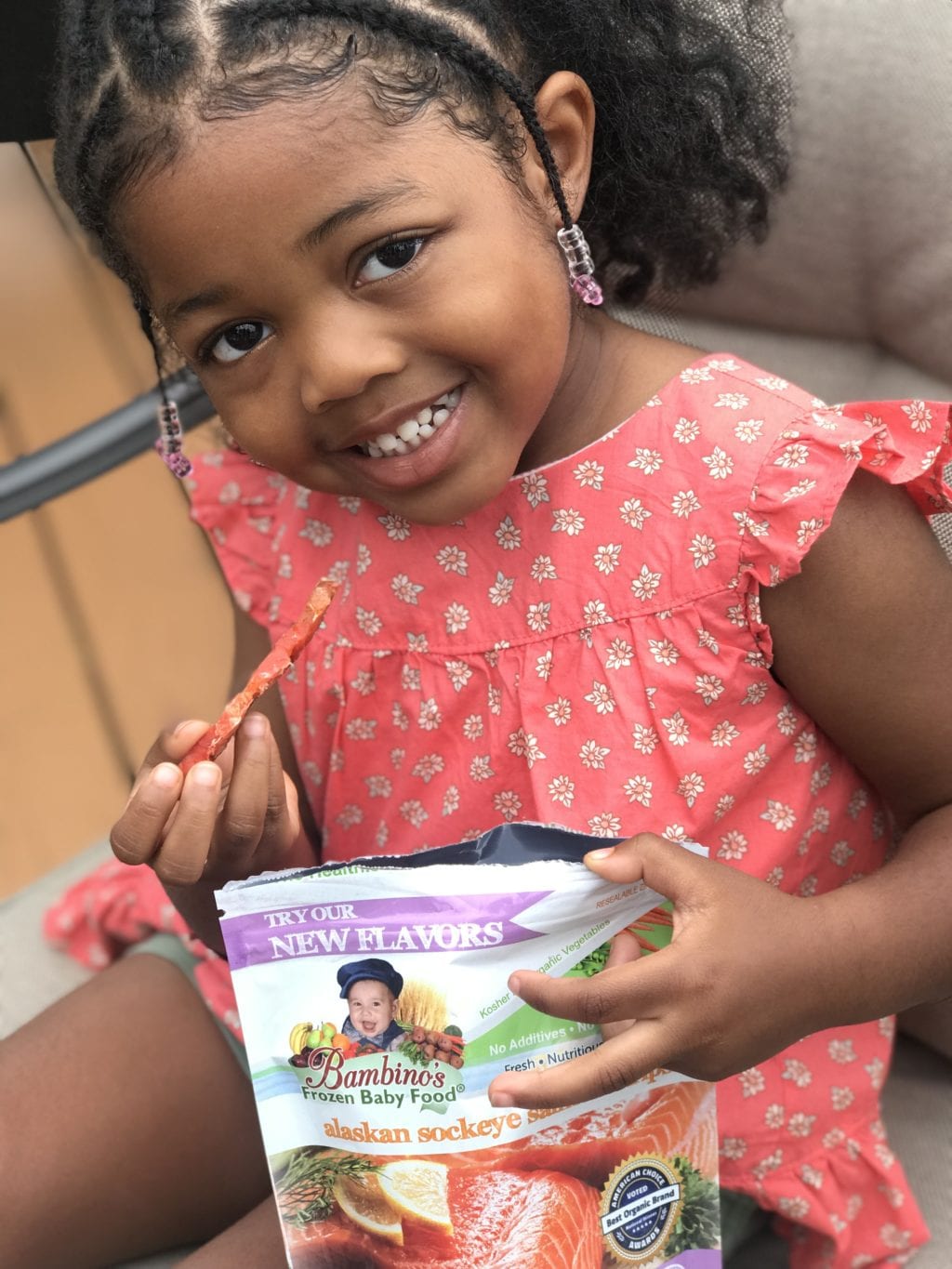
Frozen sockeye salmon strips bring tasty nutrition and relief to teething babies.
The lightly seasoned salmon strips, made mostly from Bristol Bay reds, are the third product made by Bambino’s Baby Food of Anchorage that is aimed at getting more seafood into the mouths of babes.
“I always kind of giggle because it’s not going to be just for the little ones. I’m sure mom and dad and elder brother or sister are going to be gnawing on those as well,” said Zoi Maroudas, Bambino’s founder and operator. “I also wanted to honor our indigenous families and traditions and share how natural, nutrient-rich omega strips can be so good for a little one to enjoy. Instead of a cookie or cracker, a frozen salmon strip.”
“Seeing our community and friends near and far now having the option to find Pivsi (Inupiaq for “dried fish”) at Bambino’s is very exciting and a healthy new option for kiddos,” said Lars Nelson, president of TRIBN construction company at Utqiagvik, and parent of six.

Maroudas, who was born in Greece and came to Alaska as a child (her family owns Pizza Olympia in Spenard), launched Bambino’s first seafood item, Hali-Halibut, in 2017 followed shortly after by a Sockeye Salmon Bisque. The pouched meals feature frozen, star-shaped portions that are perfect for baby-sized hands or for thawing into puree-style meals. Each contains “the perfect balance” of proteins, grains and vegetables for optimal nutritional content, she added.
The baby seafood items are among 20 Alaska grown products that are made in Maroudas’ store and production facility in Anchorage.
Bambino’s has resonated with some big names and won notable awards. Maroudas has been featured on the Today Show, Fox News, numerous magazines, by hip hop artist Uncle Murda, and she was personally honored by both Martha Stewart (she brought her sockeye salmon) and President Donald Trump. The Bambino’s line also won the American Choice Award for Best Organic Brand and Alaska’s Top Manufacturer in 2019.
Bambino’s is filling a void by America’s baby food makers who continue to completely snub seafood in their protein lines, despite its proven health benefits (they offer seafood items in Asia and Europe). And that is despite the fact that starting in 2021, new federal dietary guidelines go into effect that say along with eating two portions of seafood each week, fish should be included in babies’ diets starting at six months old.
“The omega 3s found in seafood are to a developing retina and brain what calcium is to bones,” said Dr. Tom Brenna, professor of pediatrics, chemistry and nutrition at the University of Texas/Austin and at Cornell University. “But it is not just the omega 3s, it is these great minerals that are in some cases rare in other foods. The zinc and iron and selenium and iodine … and these are just not as high as they need to be in diets that are missing seafood.”
Bambino’s is now shipped from Anchorage to customers in all 50 states and can be found at all Safeway/Carrs stores, Amazon and at Baby Vend machines at Alaska Airline terminals.
Maroudas said she doesn’t strive to be the number one baby food in sales; she aims to be the best on the market. Above all, she said feeding more children with the purest Alaska ingredients is her biggest reward.
“It’s an absolute honor to represent our state for its quality, for its nutrition,” she said. “And working together with our farmers and our fishermen to create that beautiful plate as an extension of their home, for their families wherever they are, is the most humbling, most rewarding. And at nighttime. I pray that tomorrow’s even better for everyone around the world.”
Up next for Bambino’s — an Alaska Pollock product!
Fishing updates
Lots of fishing updates and wrap ups continue across Alaska from Ketchikan to the far reaches of the Bering Sea. And lots of outlooks for next year’s fisheries are starting to trickle in from state and federal managers.
The Pacific halibut fishery for this year, for example, ended on Nov. 15 and early estimates peg Alaska’s take at just under 15 million pounds out of a 16-million-pound catch limit. Results from the yearly halibut survey have raised cautious hopes for a possible uptick in some fishing regions in 2021.
“Pacific halibut appears to be holding its own, with an encouraging — if small — indication that overall weight of Catch Per Unit of Effort (CPUE), a proxy for abundance, went up by 6 percent. coastwide, reported Peggy Parker, executive director of the Halibut Association of North America.
CPUE refers to a standard “skate” of gear that is 1,800 feet long bearing 100 hooks.
Of note, the total weights per unit increased by 24 percent in the Central Gulf, the largest halibut fishing hole. The other Alaska areas did not fare as well: the WPUE at Southeast was down 5 percent, the Western Gulf dropped 6 percent, at the Aleutians, weights were down 2 percent near Dutch Harbor but up 3 percent at Adak; and the Bering Sea fishing regions increased by 8 percent. Coastwide, the WPUEs were up 6 percent.
The final halibut catch limits for next year will be revealed at the International Pacific Halibut Commission virtual meeting set for Jan. 25-29 and the fishery will open in March. The deadline to submit halibut regulatory proposals is Dec. 26.
Homer held onto its title of America’s No. 1 halibut port for landings, followed by Kodiak and Juneau.
Alaska’s sablefish fishery (black cod) also ended on Nov. 15 with 71% of its 31.7-million-pound quota crossing the docks. Kodiak, Seward and Sitka were the top ports for landings.
Another blockbuster sockeye run is projected for Bristol Bay next summer, topping 51 million reds if projections by the Alaska Department of Fish and Game hold true. That means the fishery will average over 48 million reds annually for the past 10 years. The 2021 forecast calls for a sockeye catch of 36.35 million fish.
ADF&G also is predicting an “average” pink salmon harvest for Southeast Alaska next year of 28 million fish, below the 10-year average of 34 million but better than the 2019 catch of 21 million.
Meanwhile, Southeast trollers are still out on the water fishing for winter Chinook salmon.
A few areas of the Panhandle remain open for pot shrimp and the harvest had reached 540,670 pounds.
Divers also continue pulling up geoduck clams; they have also taken 1.2 million pounds of sea cucumbers out of a 1.7-million-pound catch limit.
The region’s Dungeness fishery is ongoing through Nov. 30 and nearly 200 crabbers have landed 6.4 million pounds in the combined summer and fall fisheries.
A sea cucumber fishery at Kodiak and the westward region has a small quota of 165,000 pounds. A herring food and bait fishery opened on Nov. 14 at Kodiak with a 319-ton limit.
The nation’s biggest fishery – Alaska Pollock – just wrapped up in the Bering Sea and Gulf of Alaska until Jan. 20, producing over three billion pounds of the popular whitefish.
Cod fishing is mostly over for the year except for a small reopener in the Gulf on Nov. 23 for pot or jig boats. Other boats also continue to target various rockfish and flounders.
Catches for 2021 Bering Sea and Gulf of Alaska fisheries will be revealed when the North Pacific Fishery Management Council meets virtually from Nov. 30 to Dec. 12.
Bering Sea crabbers have taken 99 percent of their 2.38-pound red king crab quota. They also are tapping on over 2 million pounds of Tanners and more than 6 million pounds of golden king crab.
Find links to Alaska fish catches at alaskafishradio.com.
Sea cuke cures
Sea cucumbers have been considered a delicacy in Asian cuisine for centuries and also have been used in traditional Chinese medicine to help aid in many different health problems.
In his book “Cancer: Step Outside the Box”, author Ty M. Bollinger calls the spiky, slug-like creates a miracle cure for cancer.
“You can cook them for various dishes, but the way it’s found in local health food stores is dried and powdered and in capsule form,” he said, adding that dried sea cucumber extract is anti-viral, anti-bacterial and also has anti-inflammatory properties.
“Another of the fascinating things about sea cucumbers is that they are very high in chondroitin sulfate, which is commonly used to treat joint pain and arthritis. To my knowledge, they have the highest concentration of chondroitin of any animal,” Bollinger said in an interview.
While customers likely won’t see it on the labels, he added that powdered sea cucumbers also have many cancer curing abilities based on studies over the past 15 years.
“Number one, it’s cytotoxic, which means it kills cancer cells, and it also is immunomodulatory,” he explained. “So, it has both sides of what I call the cancer killing coin. If you are going to defeat cancer, you need something that regulates your immune system to where it works properly but you also must have something that is going to kill those cancer cells. The sea cucumber does both.”
Sea cucumber extract also is used as an adjunct treatment for those undergoing chemotherapy, Bollinger said, because it’s very effective at mitigating the side effects of that cancer treatment.
There are over 1,250 species of sea cucumber in the world.
"tasty" - Google News
November 27, 2020 at 04:58PM
https://ift.tt/2VgDdTv
Lightly seasoned salmon strips are a tasty, health baby food - The cordova Times
"tasty" - Google News
https://ift.tt/2VXquX3
https://ift.tt/3c08sJp
Bagikan Berita Ini














0 Response to "Lightly seasoned salmon strips are a tasty, health baby food - The cordova Times"
Post a Comment